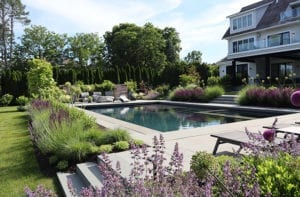Candid Camera
July 13, 2009
Text by Caroline Cunningham Photography by Portrait by Lily Brooks
It’s long been suggested that the eyes are windows into the soul, but a living room can also provide a revelatory portal, particularly if you’re sitting in photographer Laura McPhee’s Brookline, Massachusetts, home. The room is intimate and warm—the walls lined with photographs and overflowing bookshelves, contemporary and traditional furnishings arranged with style, and colorful mementos of McPhee’s peripatetic life all around. There’s hardly anything you need to know about McPhee that isn’t conveyed by the contents of this small but beautiful space that reflects the passion of an artist, the searching eye of a nomad and the soul of a storyteller.
McPhee’s photographs reflect all these things about her, too. They draw the viewer in with their precise composition, lighting and exquisite detail—all of which are magnified by the large-format Deardorff camera she uses, and the large-scale presentation of her work—but it’s their emotional power that sets them apart from the work of other accomplished artists who explore similar subjects. As New York City gallery owner Bonni Benrubi observes, “There’s a heart and soul behind her work that distinguishes it from the run of the mill.”
Her portraits and landscapes have both a sweeping grandeur and a poignant intimacy, exploring not only the delicate balance of our relationship with the environment but the universal experience of connection, loss and resurrection. We are surrounded by the inexplicable, but we seek meaning and understanding in the mayhem. This is the search McPhee’s luminous images record.
When you consider the trajectory of McPhee’s career, it’s impossible not to conclude that a certain amount of genetic predetermination was at work. As she says with a laugh, “Apples just don’t fall that far from trees.” She’s the daughter of writer John McPhee, whose essays have captivated readers of The New Yorker for years, and her mother, Pryde, started and still runs a successful photography studio in Princeton, New Jersey, where McPhee grew up.
Her mother gave McPhee her first camera when she was twelve, and she went on to study under the renowned photographer Emmett Gowin when she arrived at Princeton University as an undergraduate in 1976. McPhee cites the central importance of Gowin’s influence on her work, not only as a photographer who conveys intricate narratives through a visual medium, but as a teacher who encourages students to find their own way.
McPhee has held Guggenheim and Fulbright fellowships, and she’s traveled the world to far-flung destinations, including Sri Lanka, India, Iceland and Hawaii, to make the extraordinary photographs that hang in major museums and private collections across the country. She has also spent more than twenty years teaching at the Massachusetts College of Art and Design, where she has established, alongside superstars Abelardo Morell, Nicholas Nixon (both also Brookline residents) and Barbara Bosworth, a world-class center for the study of photography.
McPhee’s work has most recently focused on the Sawtooth Mountain area of Idaho. In 2003, she was selected as the artist-in-residence by the Alturas Foundation, a family foundation with a commitment to the art and culture of the American West. McPhee spent more than two years in this remote part of the country, exploring the land, its inhabitants and the complex, often inscrutable, relationship between the two.
McPhee returned from Idaho with a large body of work, some of which she then chose to make very large, measuring more than seven feet in height. Gallery owner and close friend Bernie Toale arranged to borrow another friend’s empty, light-filled apartment in Boston’s South End and put together an impromptu exhibition of McPhee’s images to which he invited collectors and museum curators. William Stover, assistant curator of contemporary art at the Museum of Fine Arts, Boston, says, “We were all blown away. Laura’s photographs are not just of one person or place. She captures the individuality and the universality that lies beyond the specific and, in doing so, reveals how we are all part of a larger whole.”
McPhee went back to Idaho to photograph the aftermath of a 2005 forest fire that destroyed more than 40,000 acres of the valley where she’d spent so much time. She describes returning to the area, where flames were still ravaging the hillside, as akin to being in a war zone, “with smoke like nuclear mushroom clouds swirling around.”
Her photographs show the miraculous way the landscape recovers and renews itself: tiny purple flowers clustered around trunks so charred they resemble anthropomorphic limbs; a thicket of slender trees that create a jumbled fence, beyond which one sees a mountain peak washed in sunlight. The images are eloquent documents of a specific place and time. They are also documents of fragility and resilience, and of hope amidst unimaginable devastation. They’re nothing short of transcendent.
EDITOR’S NOTE Laura McPhee is represented locally by the Bernard Toale Gallery, (617) 482-2477, www.bernardtoalegallery.com. To see more of McPhee’s work, go to www.lauramcphee.com.
Share
![NEH-Logo_Black[1] NEH-Logo_Black[1]](https://www.nehomemag.com/wp-content/uploads/2022/08/NEH-Logo_Black1-300x162.jpg)
















You must be logged in to post a comment.